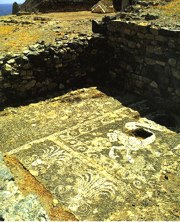The first habitation of the site dates from the Neolithic and Early Minoan period (3rd millenium B.C.). In the late Classical period (beginning of the 4th century B.C.) the Gortynians established the sanctuary of
Asklepios at the harbour. During the tremendous earthquake of 46 B.C. the city was destroyed and subsequently rebuilt. In the Early Christian and Byzantine periods, a small settlement developed and the basilica was erected.
The small Byzantine church of St. John was built in the 14th century. The archaeological investigation of the site started after the first visit of the English captain H. Spratt, in the middle of the 19th century. Excavations were carried out by the Italian Archaeological School at Athens in 1900, 1910 and 1912-13, and revealed the sanctuary and other buildings. Since then no excavation had taken place in the ancient city until recent years, when the investigations of the Greek Archaeological Service brought to light the Minoan settlement and graves.
Apart from consolidation work on the monuments, extensive restoration has not been carried out with the exception of the columns of the temple of Asklepios which were immediately restored by the excavators.
The most important monuments of the site are:
The Temple of Asklepios. It lies at the SW edge of the terrace of the sanctuary and dates from the 1st-2nd centuries A.D. The walls, built of mudbricks with a revetment of white marble, are preserved to a height of 3.40 m. Two of the marble columns and the bases of the cult statues of Asklepios and Hygeia are preserved inside the temple.

The temple is built on an artificial terrace at the SW edge of the sanctuary and is oriented to the east. The walls of the cella, preserved to a height of 3.40 m., are built of mudbricks, reveted with white marble slabs. Similar slabs cover the central part of the floor, while the rest of it is mosaic. Two of the columns (4.70 m. high) and the bases of the cult statues of Asklepios and Hygeia are preserved inside the temple.
It was constructed in the first centuries of the Roman Empire (1st-2nd century A.D.). After the expansion of Christianity the temple (and the sanctuary) were abandoned and gradually destroyed. Architectural members of the temple were used for the construction of the Byzantine basilica. In 1856, Onorio Belli drew the groundplan of the Asklepieion of which only the outline and two of the columns are still preserved today.
The temple of Asklepios was excavated, along with the rest of the sanctuary, by the Italian Archaeological School at Athens in 1900, 1910 and 1912-1913. The columns of the temple were immediately restored by the excavators.

The
"Treasury". It is earlier than the temple and the west portico, lying beneath the floor of the latter. It was built in the Hellenistic period (3rd century B.C.) and its floor is covered with mosaics, forming two "panels" depicting a seahorse and palmettes. The mosaic covered the mouth of the "Treasury" (a well 1.90 m. deep, where the offerings were kept).
The Fountain, located to the south of the Nymphaion.
Large, three-aisled basilica. Ruins of the church, dated earlier than the 9th century A.D., were found underneath the basilica of St. John.
Early Minoan settlement (2600-2000 B.C.) on the low hill called Anginaropapouro.
The West Stoa. It extends to the north of the temple and is almost 27 m. long. In the northern part are preserved the thresholds of three doorways leading to rooms on the west, which were probably used by the priests and the temple personnel. The West Stoa and the temple were built in the period of the heyday of the Roman Empire (1st-2nd century A.D.).
The North Stoa. It was built before the temple (2nd century B.C.), into which it was later incorporated. Bases and parts of columns along with marble slabs are preserved.
Most likely it was the "adyton" or "abaton" (sanctuary) of the shrine.
The Nymphaion. Room with two arches built of mudbricks, located at the east edge of the North Stoa.
Two large, mud-brick cisterns, used possibly for therapeutic baths.
Source:
The Hellenic Ministry of Culture